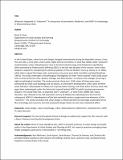| dc.contributor.author | Ryan, Brent D. | |
| dc.date.accessioned | 2014-07-10T15:44:03Z | |
| dc.date.available | 2014-07-10T15:44:03Z | |
| dc.date.issued | 2013-05 | |
| dc.identifier.issn | 1357-4809 | |
| dc.identifier.issn | 1469-9664 | |
| dc.identifier.uri | http://hdl.handle.net/1721.1/88249 | |
| dc.description.abstract | In the United States, urban form and design changed tremendously during the twentieth century. From the early twentieth century, a time when small-scale, highly diverse city blocks or what Douglas Rae called “urbanism” predominated, urban redevelopment came to be dominated by large-scale modernist superblocks, often promoted by federal policy. In the last two decades of the century, some urban designers argued for recapturing the physical qualities of the premodern city, while others argued that large-scale, autonomous city areas were both inevitable and ideal. This study undertakes a morphological investigation of three “twice-cleared” urban sites in three American cities—Boston, Chicago, and New Orleans—to measure the changes occurring in eight morphological variables. The study examines three eras: 1910, when all three sites were dominated by small-scale buildings and city blocks, or premodern development; 1950, when all three sites had been redeveloped for Modernism-inspired public housing; and 2010, when all three sites had again been redeveloped under the federal, historicist-inspired HOPE VI public housing improvement program. The study found that HOPE VI was able to recover only some of the “urbanism” that Modernism eradicated in the mid 20th century. The study concludes that urban design is influenced by seemingly unalterable forces like technology and economy, but that purposeful design ideals can also have substantial effects. | en_US |
| dc.description.sponsorship | Harvard University. Graduate School of Design (Dean’s Research and Faculty Development Grant) | en_US |
| dc.language.iso | en_US | |
| dc.publisher | Taylor & Francis | en_US |
| dc.relation.isversionof | http://dx.doi.org/10.1080/13574809.2013.772885 | en_US |
| dc.rights | Creative Commons Attribution-Noncommercial-Share Alike | en_US |
| dc.rights.uri | http://creativecommons.org/licenses/by-nc-sa/4.0/ | en_US |
| dc.source | MIT web domain | en_US |
| dc.title | Whatever Happened to “Urbanism”? A Comparison of Premodern, Modernist, and HOPE VI Morphology in Three American Cities | en_US |
| dc.type | Article | en_US |
| dc.identifier.citation | Ryan, Brent D. “Whatever Happened to ‘Urbanism’? A Comparison of Premodern, Modernist, and HOPE VI Morphology in Three American Cities.” Journal of Urban Design 18, no. 2 (May 2013): 201–219. | en_US |
| dc.contributor.department | Massachusetts Institute of Technology. Department of Urban Studies and Planning | en_US |
| dc.contributor.mitauthor | Ryan, Brent D. | en_US |
| dc.relation.journal | Journal of Urban Design | en_US |
| dc.eprint.version | Author's final manuscript | en_US |
| dc.type.uri | http://purl.org/eprint/type/JournalArticle | en_US |
| eprint.status | http://purl.org/eprint/status/PeerReviewed | en_US |
| dspace.orderedauthors | Ryan, Brent D. | en_US |
| dc.identifier.orcid | https://orcid.org/0000-0002-0223-1887 | |
| mit.license | OPEN_ACCESS_POLICY | en_US |
| mit.metadata.status | Complete | |
